Telemedicine in Africa: ICT, Challenges, and Recommendations Report
VerifiedAdded on 2023/06/04
|8
|1690
|87
Report
AI Summary
This report provides an in-depth analysis of the RAFT telemedicine project in Africa, a network developed by the University of Geneva and University hospitals. It examines the project's benefits, particularly in low and middle-income countries (LMICs), where it addresses healthcare professional shortages and quality care disparities. The report identifies critical challenges, including financial sustainability issues, inadequate infrastructure (roads, internet), and management deficiencies hindering telemedicine adoption. It evaluates available support structures like mHealth initiatives and hospital information systems. Furthermore, it recommends strategies to overcome these obstacles, such as awareness campaigns, technological integration, and government policy implementation. The report also contrasts these challenges with the current state of telemedicine in Australia. The report then concludes by synthesizing the challenges and potential solutions to improve healthcare services in Africa and Australia, emphasizing the importance of financial investment, rural community engagement, and government support.
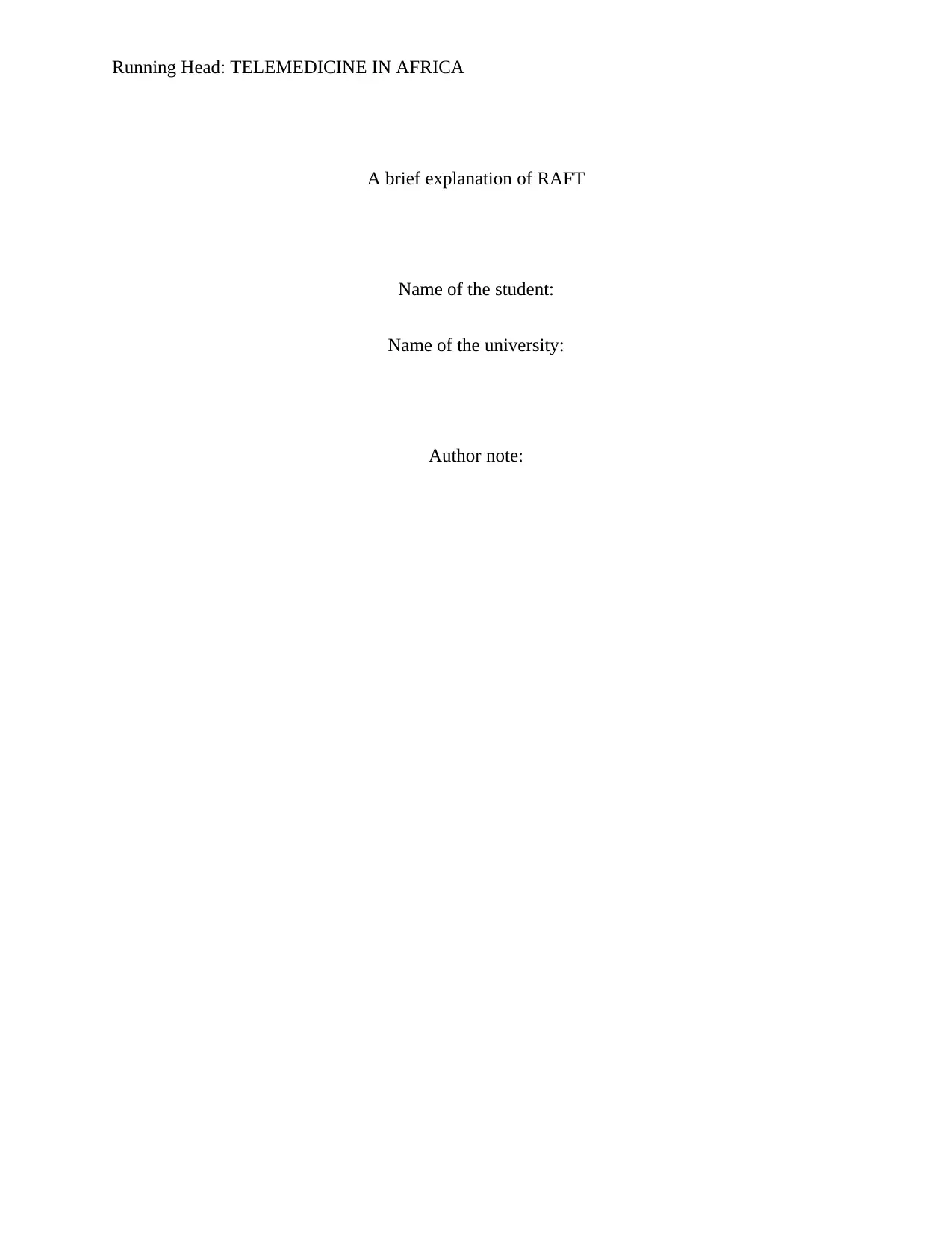
Running Head: TELEMEDICINE IN AFRICA
A brief explanation of RAFT
Name of the student:
Name of the university:
Author note:
A brief explanation of RAFT
Name of the student:
Name of the university:
Author note:
Paraphrase This Document
Need a fresh take? Get an instant paraphrase of this document with our AI Paraphraser
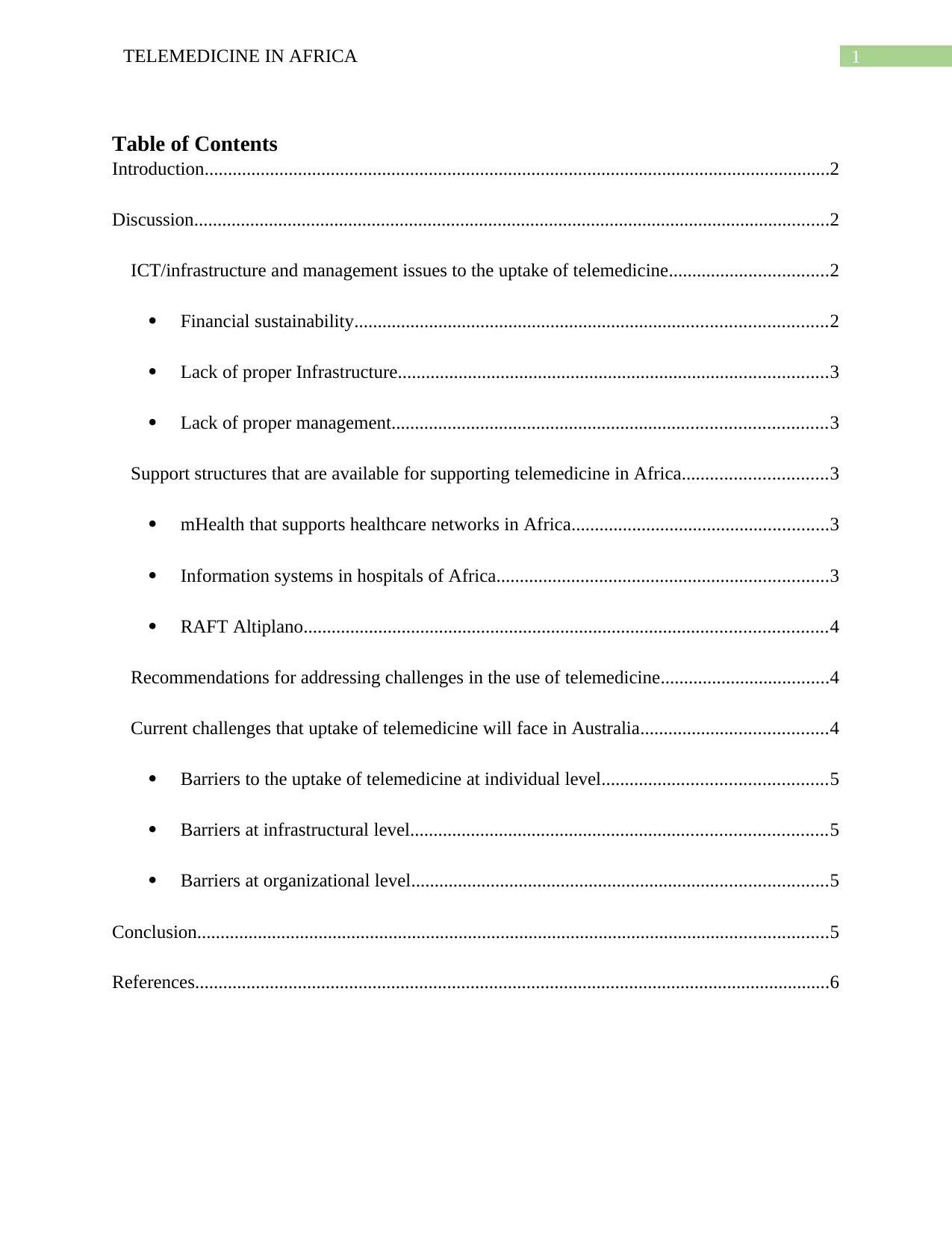
1TELEMEDICINE IN AFRICA
Table of Contents
Introduction......................................................................................................................................2
Discussion........................................................................................................................................2
ICT/infrastructure and management issues to the uptake of telemedicine..................................2
Financial sustainability.....................................................................................................2
Lack of proper Infrastructure............................................................................................3
Lack of proper management.............................................................................................3
Support structures that are available for supporting telemedicine in Africa...............................3
mHealth that supports healthcare networks in Africa.......................................................3
Information systems in hospitals of Africa.......................................................................3
RAFT Altiplano................................................................................................................4
Recommendations for addressing challenges in the use of telemedicine....................................4
Current challenges that uptake of telemedicine will face in Australia........................................4
Barriers to the uptake of telemedicine at individual level................................................5
Barriers at infrastructural level.........................................................................................5
Barriers at organizational level.........................................................................................5
Conclusion.......................................................................................................................................5
References........................................................................................................................................6
Table of Contents
Introduction......................................................................................................................................2
Discussion........................................................................................................................................2
ICT/infrastructure and management issues to the uptake of telemedicine..................................2
Financial sustainability.....................................................................................................2
Lack of proper Infrastructure............................................................................................3
Lack of proper management.............................................................................................3
Support structures that are available for supporting telemedicine in Africa...............................3
mHealth that supports healthcare networks in Africa.......................................................3
Information systems in hospitals of Africa.......................................................................3
RAFT Altiplano................................................................................................................4
Recommendations for addressing challenges in the use of telemedicine....................................4
Current challenges that uptake of telemedicine will face in Australia........................................4
Barriers to the uptake of telemedicine at individual level................................................5
Barriers at infrastructural level.........................................................................................5
Barriers at organizational level.........................................................................................5
Conclusion.......................................................................................................................................5
References........................................................................................................................................6
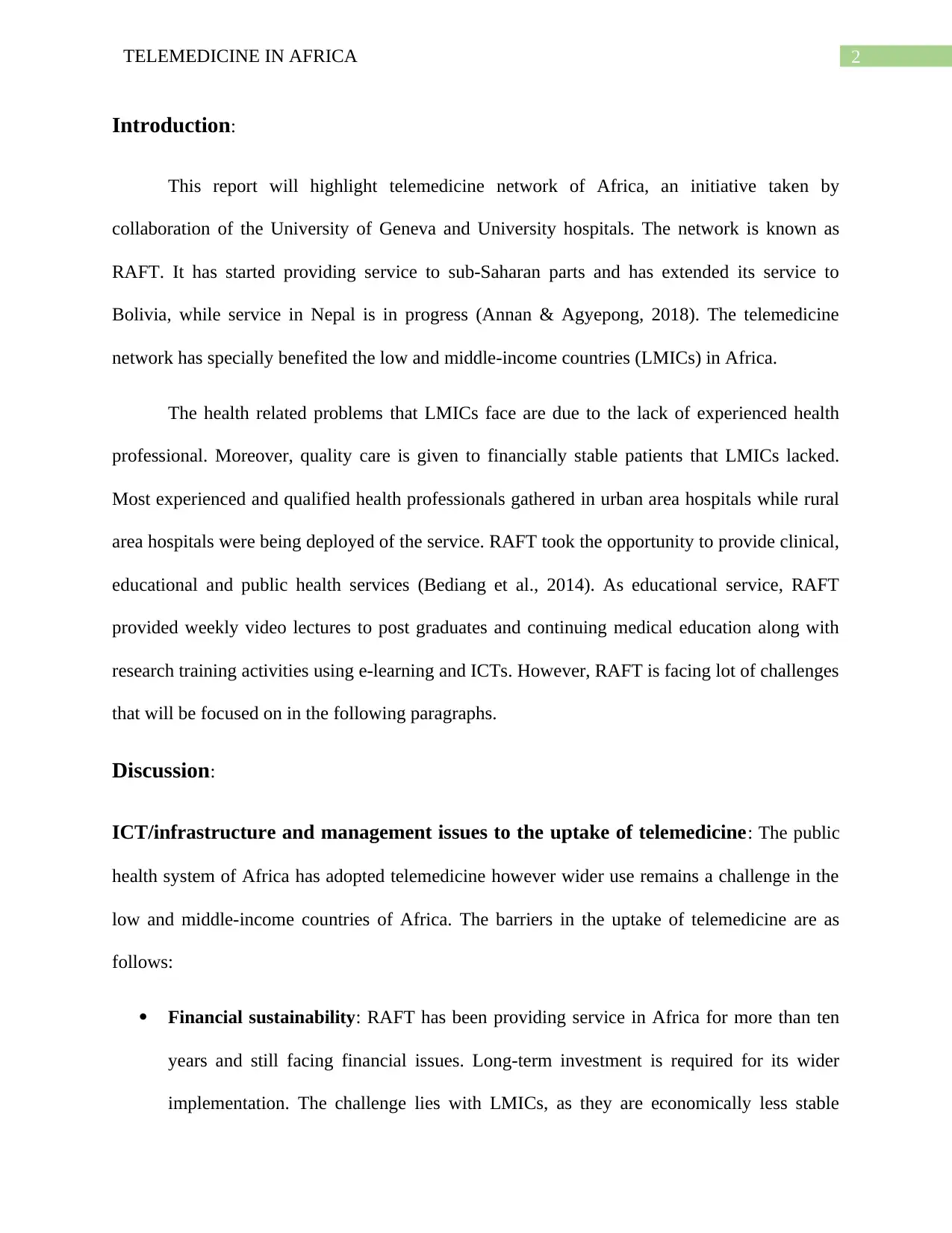
2TELEMEDICINE IN AFRICA
Introduction:
This report will highlight telemedicine network of Africa, an initiative taken by
collaboration of the University of Geneva and University hospitals. The network is known as
RAFT. It has started providing service to sub-Saharan parts and has extended its service to
Bolivia, while service in Nepal is in progress (Annan & Agyepong, 2018). The telemedicine
network has specially benefited the low and middle-income countries (LMICs) in Africa.
The health related problems that LMICs face are due to the lack of experienced health
professional. Moreover, quality care is given to financially stable patients that LMICs lacked.
Most experienced and qualified health professionals gathered in urban area hospitals while rural
area hospitals were being deployed of the service. RAFT took the opportunity to provide clinical,
educational and public health services (Bediang et al., 2014). As educational service, RAFT
provided weekly video lectures to post graduates and continuing medical education along with
research training activities using e-learning and ICTs. However, RAFT is facing lot of challenges
that will be focused on in the following paragraphs.
Discussion:
ICT/infrastructure and management issues to the uptake of telemedicine: The public
health system of Africa has adopted telemedicine however wider use remains a challenge in the
low and middle-income countries of Africa. The barriers in the uptake of telemedicine are as
follows:
Financial sustainability: RAFT has been providing service in Africa for more than ten
years and still facing financial issues. Long-term investment is required for its wider
implementation. The challenge lies with LMICs, as they are economically less stable
Introduction:
This report will highlight telemedicine network of Africa, an initiative taken by
collaboration of the University of Geneva and University hospitals. The network is known as
RAFT. It has started providing service to sub-Saharan parts and has extended its service to
Bolivia, while service in Nepal is in progress (Annan & Agyepong, 2018). The telemedicine
network has specially benefited the low and middle-income countries (LMICs) in Africa.
The health related problems that LMICs face are due to the lack of experienced health
professional. Moreover, quality care is given to financially stable patients that LMICs lacked.
Most experienced and qualified health professionals gathered in urban area hospitals while rural
area hospitals were being deployed of the service. RAFT took the opportunity to provide clinical,
educational and public health services (Bediang et al., 2014). As educational service, RAFT
provided weekly video lectures to post graduates and continuing medical education along with
research training activities using e-learning and ICTs. However, RAFT is facing lot of challenges
that will be focused on in the following paragraphs.
Discussion:
ICT/infrastructure and management issues to the uptake of telemedicine: The public
health system of Africa has adopted telemedicine however wider use remains a challenge in the
low and middle-income countries of Africa. The barriers in the uptake of telemedicine are as
follows:
Financial sustainability: RAFT has been providing service in Africa for more than ten
years and still facing financial issues. Long-term investment is required for its wider
implementation. The challenge lies with LMICs, as they are economically less stable
⊘ This is a preview!⊘
Do you want full access?
Subscribe today to unlock all pages.

Trusted by 1+ million students worldwide
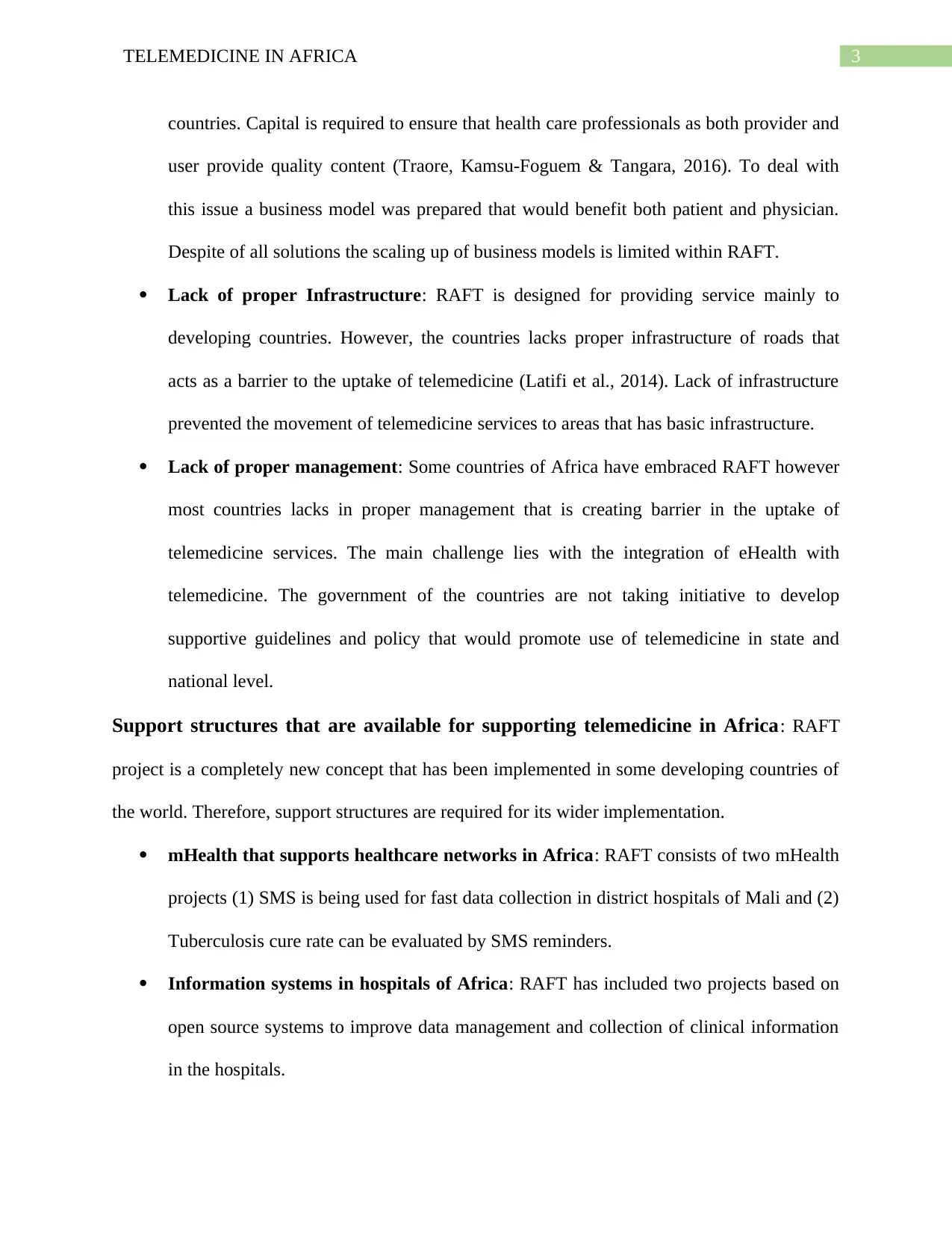
3TELEMEDICINE IN AFRICA
countries. Capital is required to ensure that health care professionals as both provider and
user provide quality content (Traore, Kamsu-Foguem & Tangara, 2016). To deal with
this issue a business model was prepared that would benefit both patient and physician.
Despite of all solutions the scaling up of business models is limited within RAFT.
Lack of proper Infrastructure: RAFT is designed for providing service mainly to
developing countries. However, the countries lacks proper infrastructure of roads that
acts as a barrier to the uptake of telemedicine (Latifi et al., 2014). Lack of infrastructure
prevented the movement of telemedicine services to areas that has basic infrastructure.
Lack of proper management: Some countries of Africa have embraced RAFT however
most countries lacks in proper management that is creating barrier in the uptake of
telemedicine services. The main challenge lies with the integration of eHealth with
telemedicine. The government of the countries are not taking initiative to develop
supportive guidelines and policy that would promote use of telemedicine in state and
national level.
Support structures that are available for supporting telemedicine in Africa: RAFT
project is a completely new concept that has been implemented in some developing countries of
the world. Therefore, support structures are required for its wider implementation.
mHealth that supports healthcare networks in Africa: RAFT consists of two mHealth
projects (1) SMS is being used for fast data collection in district hospitals of Mali and (2)
Tuberculosis cure rate can be evaluated by SMS reminders.
Information systems in hospitals of Africa: RAFT has included two projects based on
open source systems to improve data management and collection of clinical information
in the hospitals.
countries. Capital is required to ensure that health care professionals as both provider and
user provide quality content (Traore, Kamsu-Foguem & Tangara, 2016). To deal with
this issue a business model was prepared that would benefit both patient and physician.
Despite of all solutions the scaling up of business models is limited within RAFT.
Lack of proper Infrastructure: RAFT is designed for providing service mainly to
developing countries. However, the countries lacks proper infrastructure of roads that
acts as a barrier to the uptake of telemedicine (Latifi et al., 2014). Lack of infrastructure
prevented the movement of telemedicine services to areas that has basic infrastructure.
Lack of proper management: Some countries of Africa have embraced RAFT however
most countries lacks in proper management that is creating barrier in the uptake of
telemedicine services. The main challenge lies with the integration of eHealth with
telemedicine. The government of the countries are not taking initiative to develop
supportive guidelines and policy that would promote use of telemedicine in state and
national level.
Support structures that are available for supporting telemedicine in Africa: RAFT
project is a completely new concept that has been implemented in some developing countries of
the world. Therefore, support structures are required for its wider implementation.
mHealth that supports healthcare networks in Africa: RAFT consists of two mHealth
projects (1) SMS is being used for fast data collection in district hospitals of Mali and (2)
Tuberculosis cure rate can be evaluated by SMS reminders.
Information systems in hospitals of Africa: RAFT has included two projects based on
open source systems to improve data management and collection of clinical information
in the hospitals.
Paraphrase This Document
Need a fresh take? Get an instant paraphrase of this document with our AI Paraphraser
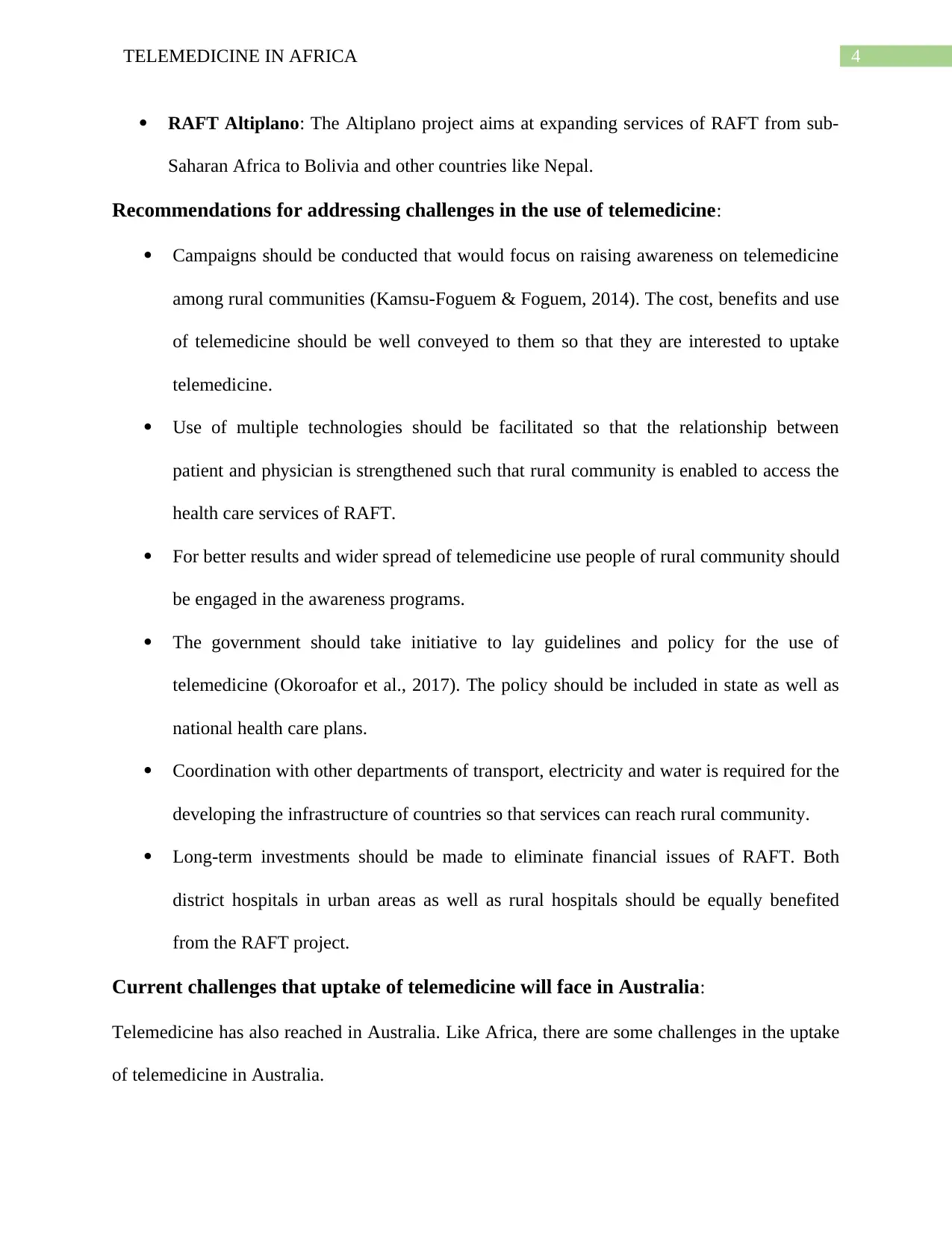
4TELEMEDICINE IN AFRICA
RAFT Altiplano: The Altiplano project aims at expanding services of RAFT from sub-
Saharan Africa to Bolivia and other countries like Nepal.
Recommendations for addressing challenges in the use of telemedicine:
Campaigns should be conducted that would focus on raising awareness on telemedicine
among rural communities (Kamsu-Foguem & Foguem, 2014). The cost, benefits and use
of telemedicine should be well conveyed to them so that they are interested to uptake
telemedicine.
Use of multiple technologies should be facilitated so that the relationship between
patient and physician is strengthened such that rural community is enabled to access the
health care services of RAFT.
For better results and wider spread of telemedicine use people of rural community should
be engaged in the awareness programs.
The government should take initiative to lay guidelines and policy for the use of
telemedicine (Okoroafor et al., 2017). The policy should be included in state as well as
national health care plans.
Coordination with other departments of transport, electricity and water is required for the
developing the infrastructure of countries so that services can reach rural community.
Long-term investments should be made to eliminate financial issues of RAFT. Both
district hospitals in urban areas as well as rural hospitals should be equally benefited
from the RAFT project.
Current challenges that uptake of telemedicine will face in Australia:
Telemedicine has also reached in Australia. Like Africa, there are some challenges in the uptake
of telemedicine in Australia.
RAFT Altiplano: The Altiplano project aims at expanding services of RAFT from sub-
Saharan Africa to Bolivia and other countries like Nepal.
Recommendations for addressing challenges in the use of telemedicine:
Campaigns should be conducted that would focus on raising awareness on telemedicine
among rural communities (Kamsu-Foguem & Foguem, 2014). The cost, benefits and use
of telemedicine should be well conveyed to them so that they are interested to uptake
telemedicine.
Use of multiple technologies should be facilitated so that the relationship between
patient and physician is strengthened such that rural community is enabled to access the
health care services of RAFT.
For better results and wider spread of telemedicine use people of rural community should
be engaged in the awareness programs.
The government should take initiative to lay guidelines and policy for the use of
telemedicine (Okoroafor et al., 2017). The policy should be included in state as well as
national health care plans.
Coordination with other departments of transport, electricity and water is required for the
developing the infrastructure of countries so that services can reach rural community.
Long-term investments should be made to eliminate financial issues of RAFT. Both
district hospitals in urban areas as well as rural hospitals should be equally benefited
from the RAFT project.
Current challenges that uptake of telemedicine will face in Australia:
Telemedicine has also reached in Australia. Like Africa, there are some challenges in the uptake
of telemedicine in Australia.
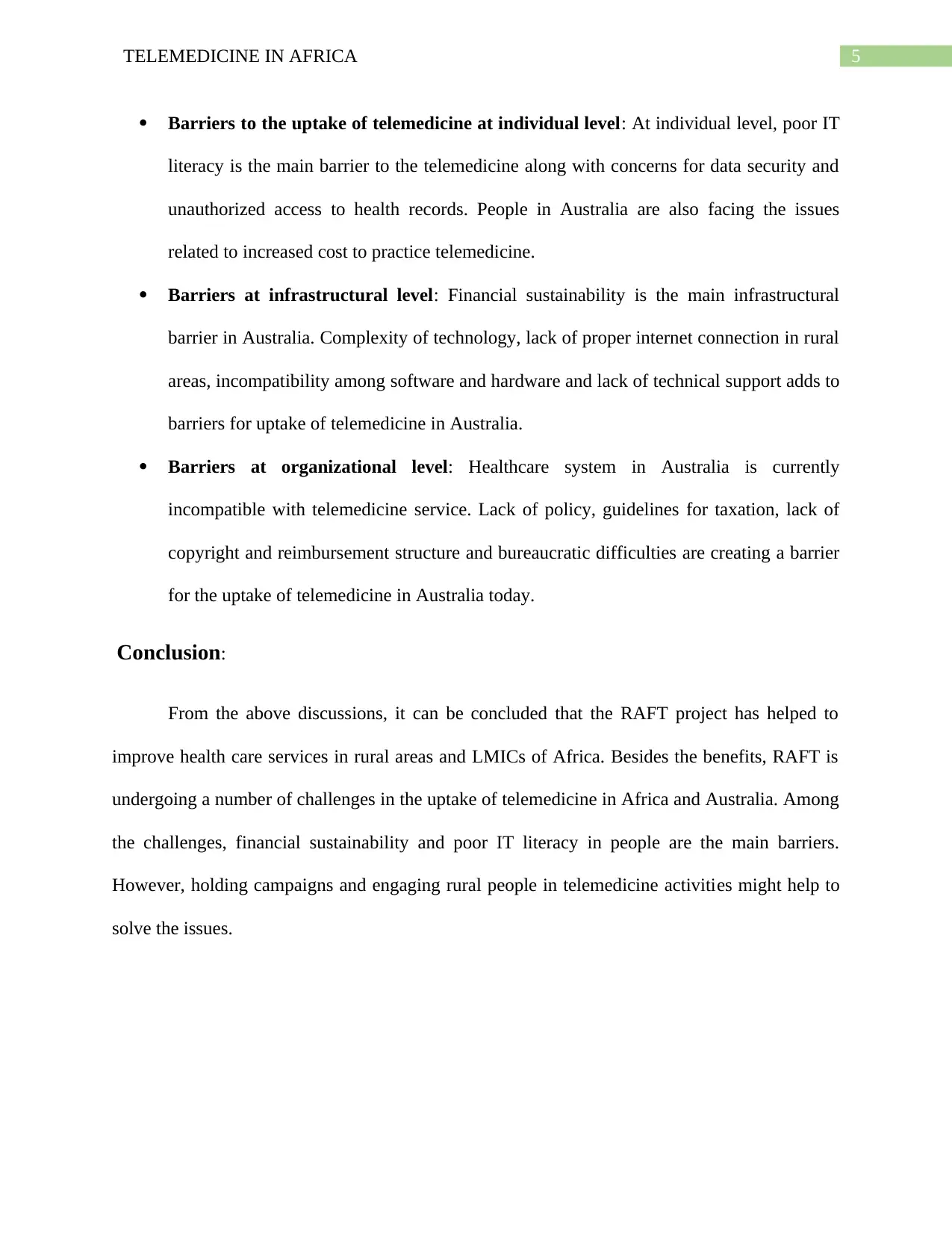
5TELEMEDICINE IN AFRICA
Barriers to the uptake of telemedicine at individual level: At individual level, poor IT
literacy is the main barrier to the telemedicine along with concerns for data security and
unauthorized access to health records. People in Australia are also facing the issues
related to increased cost to practice telemedicine.
Barriers at infrastructural level: Financial sustainability is the main infrastructural
barrier in Australia. Complexity of technology, lack of proper internet connection in rural
areas, incompatibility among software and hardware and lack of technical support adds to
barriers for uptake of telemedicine in Australia.
Barriers at organizational level: Healthcare system in Australia is currently
incompatible with telemedicine service. Lack of policy, guidelines for taxation, lack of
copyright and reimbursement structure and bureaucratic difficulties are creating a barrier
for the uptake of telemedicine in Australia today.
Conclusion:
From the above discussions, it can be concluded that the RAFT project has helped to
improve health care services in rural areas and LMICs of Africa. Besides the benefits, RAFT is
undergoing a number of challenges in the uptake of telemedicine in Africa and Australia. Among
the challenges, financial sustainability and poor IT literacy in people are the main barriers.
However, holding campaigns and engaging rural people in telemedicine activities might help to
solve the issues.
Barriers to the uptake of telemedicine at individual level: At individual level, poor IT
literacy is the main barrier to the telemedicine along with concerns for data security and
unauthorized access to health records. People in Australia are also facing the issues
related to increased cost to practice telemedicine.
Barriers at infrastructural level: Financial sustainability is the main infrastructural
barrier in Australia. Complexity of technology, lack of proper internet connection in rural
areas, incompatibility among software and hardware and lack of technical support adds to
barriers for uptake of telemedicine in Australia.
Barriers at organizational level: Healthcare system in Australia is currently
incompatible with telemedicine service. Lack of policy, guidelines for taxation, lack of
copyright and reimbursement structure and bureaucratic difficulties are creating a barrier
for the uptake of telemedicine in Australia today.
Conclusion:
From the above discussions, it can be concluded that the RAFT project has helped to
improve health care services in rural areas and LMICs of Africa. Besides the benefits, RAFT is
undergoing a number of challenges in the uptake of telemedicine in Africa and Australia. Among
the challenges, financial sustainability and poor IT literacy in people are the main barriers.
However, holding campaigns and engaging rural people in telemedicine activities might help to
solve the issues.
⊘ This is a preview!⊘
Do you want full access?
Subscribe today to unlock all pages.

Trusted by 1+ million students worldwide
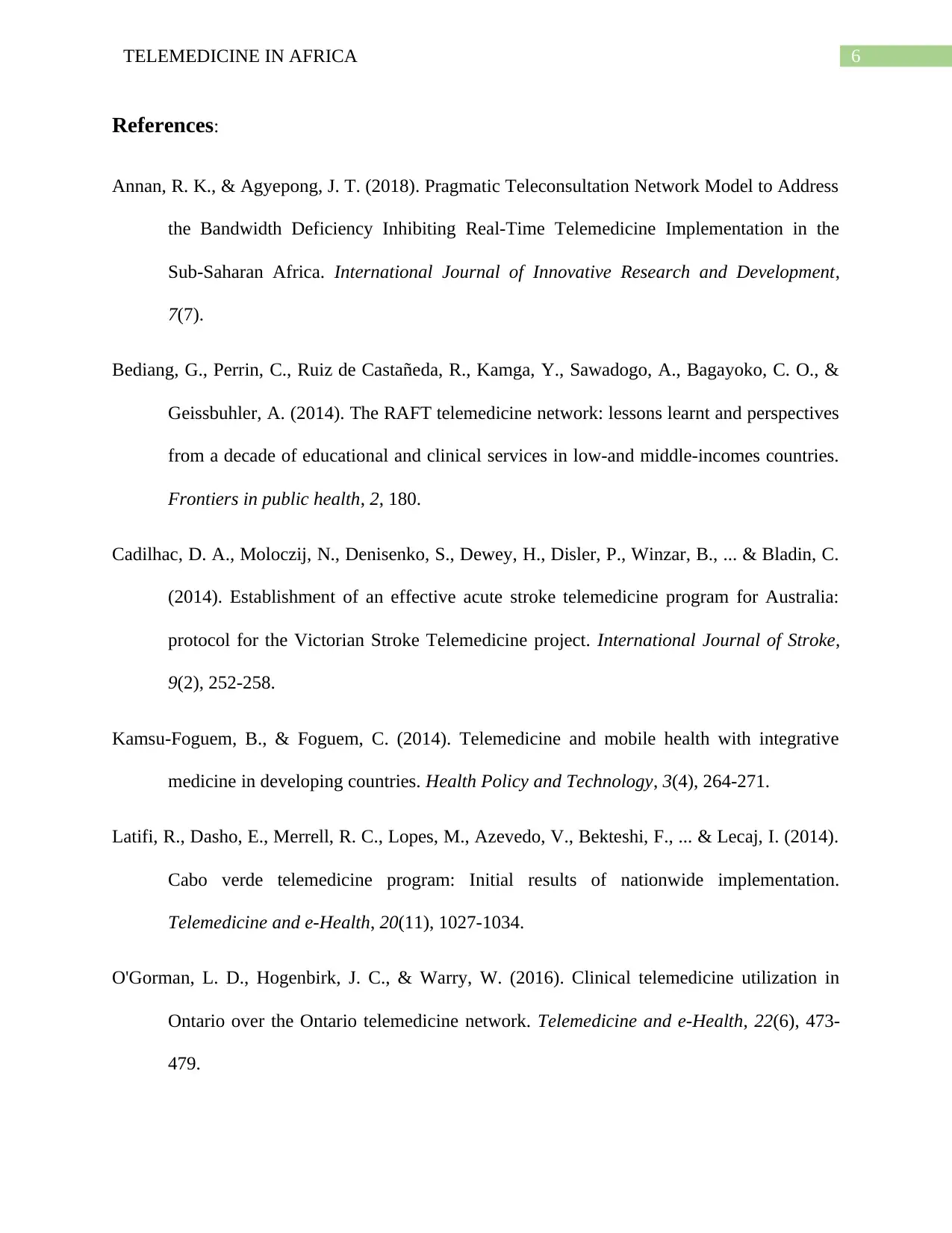
6TELEMEDICINE IN AFRICA
References:
Annan, R. K., & Agyepong, J. T. (2018). Pragmatic Teleconsultation Network Model to Address
the Bandwidth Deficiency Inhibiting Real-Time Telemedicine Implementation in the
Sub-Saharan Africa. International Journal of Innovative Research and Development,
7(7).
Bediang, G., Perrin, C., Ruiz de Castañeda, R., Kamga, Y., Sawadogo, A., Bagayoko, C. O., &
Geissbuhler, A. (2014). The RAFT telemedicine network: lessons learnt and perspectives
from a decade of educational and clinical services in low-and middle-incomes countries.
Frontiers in public health, 2, 180.
Cadilhac, D. A., Moloczij, N., Denisenko, S., Dewey, H., Disler, P., Winzar, B., ... & Bladin, C.
(2014). Establishment of an effective acute stroke telemedicine program for Australia:
protocol for the Victorian Stroke Telemedicine project. International Journal of Stroke,
9(2), 252-258.
Kamsu-Foguem, B., & Foguem, C. (2014). Telemedicine and mobile health with integrative
medicine in developing countries. Health Policy and Technology, 3(4), 264-271.
Latifi, R., Dasho, E., Merrell, R. C., Lopes, M., Azevedo, V., Bekteshi, F., ... & Lecaj, I. (2014).
Cabo verde telemedicine program: Initial results of nationwide implementation.
Telemedicine and e-Health, 20(11), 1027-1034.
O'Gorman, L. D., Hogenbirk, J. C., & Warry, W. (2016). Clinical telemedicine utilization in
Ontario over the Ontario telemedicine network. Telemedicine and e-Health, 22(6), 473-
479.
References:
Annan, R. K., & Agyepong, J. T. (2018). Pragmatic Teleconsultation Network Model to Address
the Bandwidth Deficiency Inhibiting Real-Time Telemedicine Implementation in the
Sub-Saharan Africa. International Journal of Innovative Research and Development,
7(7).
Bediang, G., Perrin, C., Ruiz de Castañeda, R., Kamga, Y., Sawadogo, A., Bagayoko, C. O., &
Geissbuhler, A. (2014). The RAFT telemedicine network: lessons learnt and perspectives
from a decade of educational and clinical services in low-and middle-incomes countries.
Frontiers in public health, 2, 180.
Cadilhac, D. A., Moloczij, N., Denisenko, S., Dewey, H., Disler, P., Winzar, B., ... & Bladin, C.
(2014). Establishment of an effective acute stroke telemedicine program for Australia:
protocol for the Victorian Stroke Telemedicine project. International Journal of Stroke,
9(2), 252-258.
Kamsu-Foguem, B., & Foguem, C. (2014). Telemedicine and mobile health with integrative
medicine in developing countries. Health Policy and Technology, 3(4), 264-271.
Latifi, R., Dasho, E., Merrell, R. C., Lopes, M., Azevedo, V., Bekteshi, F., ... & Lecaj, I. (2014).
Cabo verde telemedicine program: Initial results of nationwide implementation.
Telemedicine and e-Health, 20(11), 1027-1034.
O'Gorman, L. D., Hogenbirk, J. C., & Warry, W. (2016). Clinical telemedicine utilization in
Ontario over the Ontario telemedicine network. Telemedicine and e-Health, 22(6), 473-
479.
Paraphrase This Document
Need a fresh take? Get an instant paraphrase of this document with our AI Paraphraser
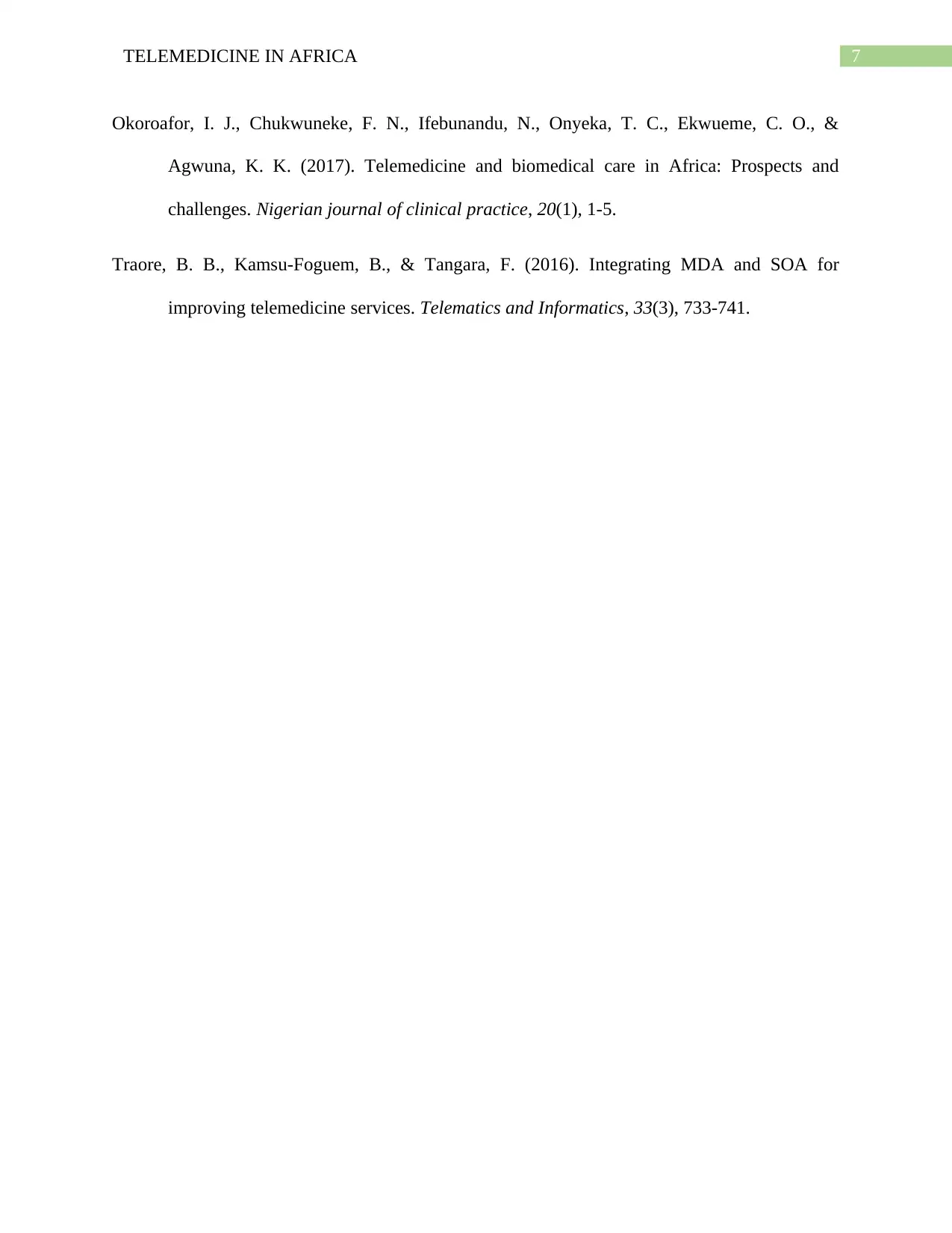
7TELEMEDICINE IN AFRICA
Okoroafor, I. J., Chukwuneke, F. N., Ifebunandu, N., Onyeka, T. C., Ekwueme, C. O., &
Agwuna, K. K. (2017). Telemedicine and biomedical care in Africa: Prospects and
challenges. Nigerian journal of clinical practice, 20(1), 1-5.
Traore, B. B., Kamsu-Foguem, B., & Tangara, F. (2016). Integrating MDA and SOA for
improving telemedicine services. Telematics and Informatics, 33(3), 733-741.
Okoroafor, I. J., Chukwuneke, F. N., Ifebunandu, N., Onyeka, T. C., Ekwueme, C. O., &
Agwuna, K. K. (2017). Telemedicine and biomedical care in Africa: Prospects and
challenges. Nigerian journal of clinical practice, 20(1), 1-5.
Traore, B. B., Kamsu-Foguem, B., & Tangara, F. (2016). Integrating MDA and SOA for
improving telemedicine services. Telematics and Informatics, 33(3), 733-741.
1 out of 8
Related Documents
Your All-in-One AI-Powered Toolkit for Academic Success.
+13062052269
info@desklib.com
Available 24*7 on WhatsApp / Email
![[object Object]](/_next/static/media/star-bottom.7253800d.svg)
Unlock your academic potential
Copyright © 2020–2025 A2Z Services. All Rights Reserved. Developed and managed by ZUCOL.





